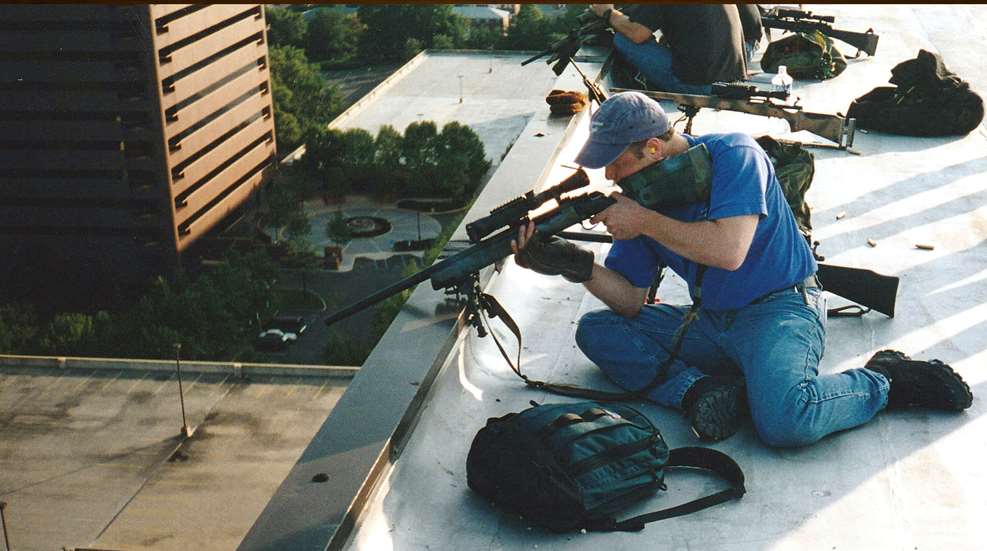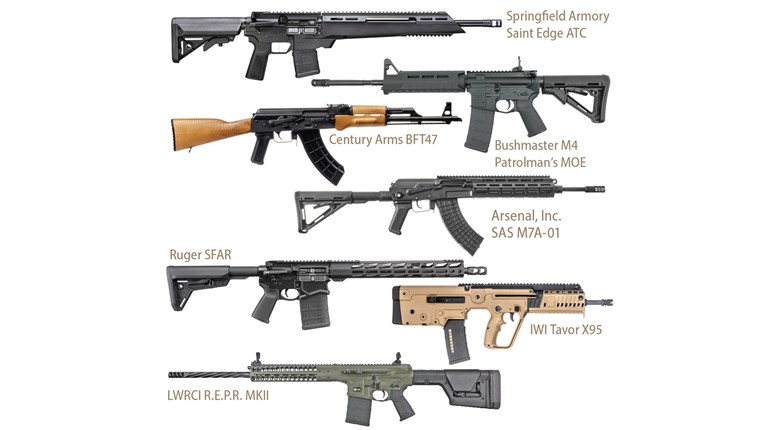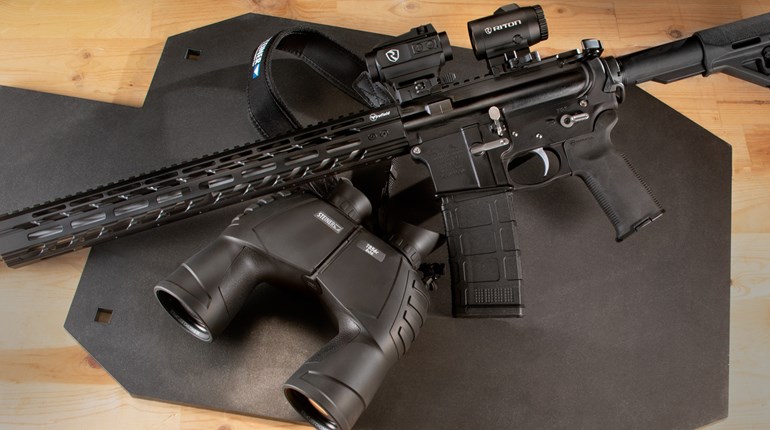
A younger, more limber version of the author enjoying the near-vertical grip on his issued McMillan A5-stocked .300 Win. Mag. during high-angle sniper training, while teammates employ .308 Win. SR-25s and conventionally stocked rifles.
It seems that the curve of ammunition cost versus availability is finally trending in the right direction. At the time of this writing, 55-grain, 5.56 NATO, brass-cased FMJ factory loads are once again available for less than $.50 per round. We are not yet at pre-freak-out levels, but it is still a positive sign. This seems to be the perfect time to talk about pistol grips, but not because the two subjects are related. I am fairly certain you are as tired of reading “Ammo Skimping 101” articles as I am of writing them, so I thought a shift of the gears might be welcome.
Prior to the advent of aftermarket pistol grips, rifle-stock designs were largely left up to gunmakers. Those of us who grew up before grip options were a thing simply accepted what came from the factory with little thought about alternatives. Having a tailored pistol grip meant either you could afford a custom stock or you were really good with a whittling knife and wood glue. We are at the opposite end of the spectrum today, with modern sporting rifles (MSRs), bolt-action chassis rigs and a growing number of other long guns allowing their owners to easily swap grips.
Aftermarket pistol-grip designs far outnumber the possible grip angles offered, but the prospective retrofitter still has decisions to make in the latter category. One could reasonably question whether or not the angle really matters. After all, our forebears came through a couple centuries’ worth of wars, subsistence hunts, defensive encounters and marksmanship competitions with straight-gripped muzzleloaders and early metallic cartridge rifles. What’s more, a healthy portion of our World War I doughboys used straight “S” stocks on their M1903 Springfield rifles. Then again, the M1917 Enfield’s semi-pistol grip, carried in much greater numbers, must have made an impression on the Yanks. For as MG Julian Hatcher notes in “Hatcher’s Notebook,” the Army’s Ordnance Department began experimenting with curved, pistol-grip stocks for the ’03 in the 1920s, using the National Matches as a test bed. Hatcher reports that it eventually settled on the curved “C” variant, incorporating it into the M1903A1 in 1928 as well as later models. Even so, I think most people are fairly “gunbidextrous” when it comes to this particular piece of furniture. I certainly fit that characterization, at least until orthopedic realities began having a say in things.
Like most young boys, a straight stick was my rifle of choice when playing war. If it had a “Y” stock on one end and a bayonet protrusion at the other, it saw multiple battles. As a teenager, I managed just fine with curved pistol grip stocks on my no-frills Ruger 10/22 and a third-hand Marlin 336. The M16 family’s A1 and A2 grips gave me no troubles during a little more than two decades in uniform. Then I hit my mid-40s and began noticing pain in my strong-side wrist when holding angled grips. Somewhere between multiple spinal injuries, surgeries, arthritis and periodic bouts of carpal tunnel syndrome, a neuropathic friend had snuck in—probably while I was trying to figure out why my sights were fuzzy. The more squared my shoulders were to the target, the worse the arm pain. When the aching invaded my weekly prone sessions, I knew I had to make some changes.
Fortunately, I remembered something I had discovered as a young sniper in the mid-1990s. My team’s rule was that you had to master your .308 Win. and pass sniper school before moving up to any of the bigger guns. Once through those wickets, I eagerly began learning the ropes with a McMillan A5-stocked rifle in .300 Win. Mag. that made me appear to be a good shooter. The near-vertical grip of the A5 stock was much more natural to my wrist, making multi-positional shooting very comfortable and providing better control during recoil and faster follow-through. After realizing that this old lesson may be applicable to my semi-automatic rifles, I set about measuring aftermarket grips in search of a better solution.
Speaking of measuring, there appear to be several ways to check this angle. I have no idea how grip makers do it—their reported angles make no sense to me. I use a machinist’s protractor to measure the acute angle formed between the grip’s centerline and the line of bore as it extends rearward over the pistol grip. The familiar A2 grip’s 52-degree angle is still used on many off-the-shelf MSRs, making it a good reference point. For rifles that accept AR-style pistol grips, the Ergo Grip (60 degrees) and Magpul MOE (62 degrees) begin moving the hand toward a more vertical attitude.
Magpul’s MOE-K (66 degrees) and BCM’s Mod 3 (68 degrees) are where I start to feel the difference. My arm pain virtually disappears when using Magpul’s MOE-K2 (72 degrees) or Tactical Link’s PDW grip (75 degrees). I have yet to try MDT’s Vertical Grip Premier or Ergo’s TDX-0, but they are about as true to 90 degrees as can be had. Through modular frontstraps and/or backstraps, Magpul’s MIAD, BCM’s Mod 2 and Mission First Tactical’s EPGI16 grips allow changes for hand size and minor wrist-angle adjustments. Going a step further, XTech Tactical, HexMag and Battle Arms Development each offer some form of an adjustable, three-position grip.
FAL shooters seeking relief from the severe, rearward rake of this rifle’s commonly issued grips can opt for less radical replacements from Mako, DSA and Ergo. The AK platform’s grip has a fairly comfortable angle, but many people find its diminutive size less than comfortable. Replacements from Hogue, Mission First, US Palm and Carolina Shooters Supply provide different angle and size options for this popular family of carbines.
The parts market has a lot to offer rifle shooters who want to modify their firing-hand holds. Options with more or less angle can better suit different shooting styles and ease some of what ails one’s firing arm. Best of all, if your rifle allows for easy grip changes, this is one of the least expensive modifications you can make. Most aftermarket pistol grips fall into the $15 to $40 range and, given that the payoff is a better shooting experience, it is money well spent.





































